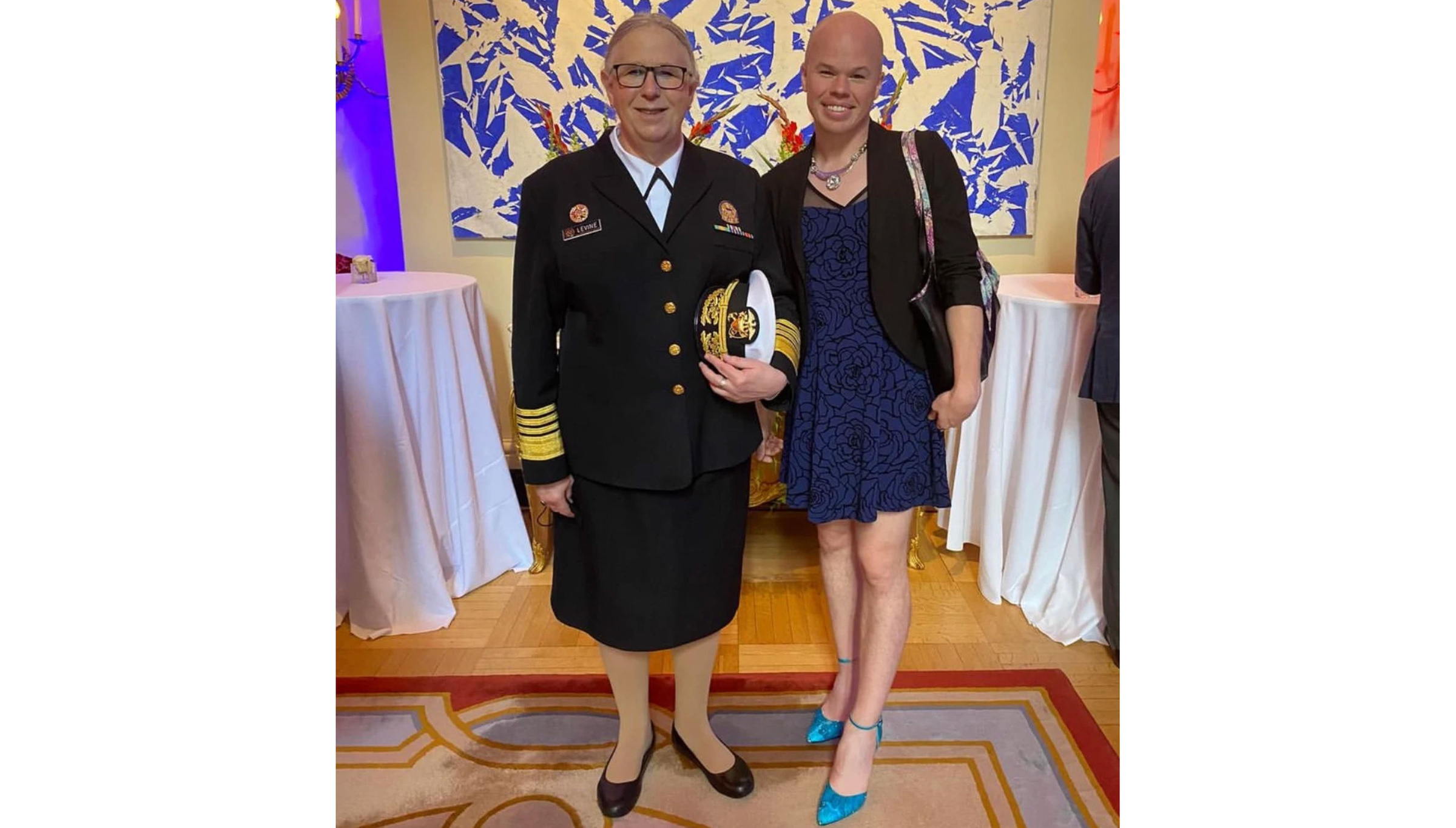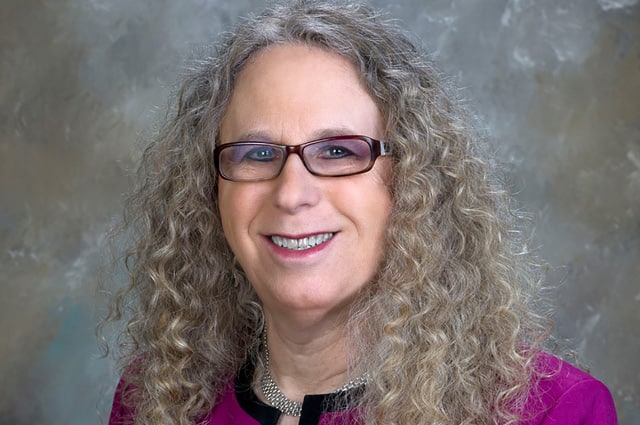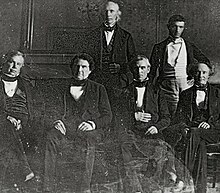В резиденции французского посла в Америке недавно прошёл приём по случаю годовщины взятия Бастилии. Светское мероприятие посетили первые в истории трансгендеры, назначенные на федеральные должности: изменившая пол адмирал Службы общественного здравоохранения США Рейчел (Ричард) Левин и небинарный кинки-трансвестит, заместитель помощника министра ядерной энергетики Сэм Бринтон.
Рейчел Левин надела строгую форму, а ниже пояса — юбку и колготки. Сэм Бринтон облачился в синее платье и ярко-голубые туфли на каблуках.
— Представилась возможность поговорить с одним из немногих трансгендерных чиновников, адмиралом Левином. Не буду врать, было здорово посочувствовать другому трансгендеру, столкнувшемуся с ненавистью, — написал Сэм Бринтон в Instagram* и выложил фото, которое завирусилось в Сети.
Оба высокопоставленных извращенца поддерживают Украину, пропагандируют радужные ценности и обвиняют Россию в притеснении сексуальных меньшинств и отсталости.
Рейчел Левин (слева) и Сэм Бринтон (справа) на приёме у французского посла. Фото © Instagram (запрещён на территории Российской Федерации) / radioaactivenerd1
Учёный-ядерщик в юбке и его люди-собаки
34-летняя Сэм Бринтон — небинарный, то есть бесполый трансвестит. Таких на Западе называют не «он» или «она», а местоимением they/them. Вдобавок у американского чиновника есть «кинк» (отклонение. — Прим. Лайфа) — укрощение «нижних» мужчин, играющих роль послушных собак в БДСМ-оргиях. На языке субкультуры это извращение называется pup handler — «дрессировщик щенков». О любви к животным ролевым играм и своей «собачке» по кличке Нуби Бринтон, не краснея, признался в интервью Metro Weekly. У Сэма Бритона есть и официальный муж — Кевин Рик.
— Однажды я помог маленькому мальчику обнять свою внутреннюю принцессу в Диснейленде, когда он увидел, как я иду на шпильках со своим парнем, — как-то заявил Бринтон телевизионщикам.
«Небинарный» родился в штате Айова. Родители, баптисты-миссионеры, не одобряли его сексуальное влечение к однокласснику и отправили на лечение псевдонаучной конверсионной терапией, когда геев переучивают в гетеросексуалов. Эта история известна только со слов Бринтона. Его биография скудна. Он словно выскочил из ниоткуда, когда со слезами на глазах рассказал журналистам New York Times, какой варварский и болезненный опыт ему пришлось пережить. На волне интереса к своей персоне Сэм Бринтон основал движение Trevor Project, борющееся с самоубийствами в ЛГБТК-сообществе. Сейчас у него новая семья: его приняли за родного сына родители мужа.
Сэм Бринтон выступает на ЛГБТК-митинге. Фото © Instagram (запрещён на территории Российской Федерации) / radioaactivenerd1
«Укротитель щенков» прекрасно образован. Он окончил Канзасский университет со степенями бакалавра по ядерной инженерии и вокалу. Также у него двойная степень магистратуры в области ядерной техники и ТЭС Массачусетского технологического института. Везде, где учился, Сэм Бринтон основывал студенческие центры ЛГБТК. Ещё он поёт в хоре геев.
В 2016 году Сэм Бринтон стал старшим политическим аналитиком по ядерным отходам. Полгода назад президент США Джо Байден нанял Бринтона на должность главы Департамента энергетики и утилизации топливных отходов. Недавно Сэм Бринтон и его муж Кевин Рик купили первое собственное жильё по адресу 752 College Pkwy, Rockville.
Адмирал-трансгендер
Родившийся в семье респектабельных юристов из Массачусетса, 64-летний Ричард Левин окончил Гарвардский колледж и медицинский факультет университета Тулейн, ординатуру по педиатрии и получил постдокторскую стипендию в медицинском центре Маунт-Синай на Манхэттене. Но долгие годы его карьера не развивалась. Он преподавал, заведовал подростковым отделением, прорыв произошёл после его публичного трансгендерного перехода.
Рейчел (Ричард) Левин после трансгендерного перехода. Фото © Telegram / SHOT
Нестерпимое желание стать женщиной Левин, имеющий жену и двоих детей, испытал на двадцать третьем году брака. Он развёлся, сменил пол, став Рейчел, и ушёл из семьи, чтобы жить с мужчиной. Комично, что его бывшая супруга некогда яро защищала права ЛГБТ.
В 2015-м Рейчел Левин назначили главврачом Пенсильвании, а позднее секретарём департамента здравоохранения штата. Джо Байден, став президентом США, назначил её помощником министра здравоохранения. Сенат со скрипом (52 против 48 голосов), но утвердил Рейчел четырехзвёздным адмиралом Офицерского корпуса службы общественного здравоохранения США. Это был первый случай присвоения трансгендеру высшего генеральского звания в истории страны. В начале года Рейчел Левин признали одной из женщин года по версии USA Today.
Рейчел Левин предлагает подросткам проходить лечение по гендерной аффирмации. Видео © Telegram / SHOT
Инициативы у адмирала-трансгендера интересные: она предлагает разрешить американским детям принимать гормоны, чтобы они сами решили, к какому полу относятся, а также рекламирует лечение по гендерной аффирмации для не определившихся с ориентацией подростков.
— Будучи первопроходцем сообщества ЛГБТК+ и, в частности, трансгендеров, доктор Левин непосредственно спасла тысячи жизней и дала надежду всему населению нашей страны. Её работа продолжается и сегодня, и мы можем только надеяться, что она продолжит разрушать барьеры, одновременно делая нашу страну более безопасным и здоровым местом, — восторгаются её действиями американские СМИ.
Адмирал Рейчел живёт в Пенсильвании по адресу 118 Autumnwood Dr, Middletown в особняке стоимостью полмиллиона долларов.
P. S.
Почему в США на высокие должности берут извращенцев?
Потому что и другие чиновники имеют различные психические отклонения
Они уже не видят разницы между нормальным и отклонением
Потому что у ЛГБТ очень сильное лобби
Комментариев: 1
Для комментирования авторизуйтесь!
From Wikipedia, the free encyclopedia

Great Seal of the United States |
|

President Joe Biden’s Cabinet pictured in July 2021 |
|
| Formation | March 4, 1789 (234 years ago) |
|---|---|
| Legal status | Inferred (Opinion Clause) |
| Purpose | Advisory body to the president of the United States |
| Location |
|
|
President of the United States |
Joe Biden |
|
Membership |
24 members (not counting the VP):
|
| Website | www.whitehouse.gov |
The Cabinet of the United States is a body consisting of the vice president of the United States and the heads of the executive branch’s departments in the federal government of the United States. It is the principal official advisory body to the president of the United States. The president chairs the meetings but is not formally a member of the Cabinet. The heads of departments, appointed by the president and confirmed by the Senate, are members of the Cabinet, and acting department heads also participate in Cabinet meetings whether or not they have been officially nominated for Senate confirmation. The president may designate heads of other agencies and non-Senate-confirmed members of the Executive Office of the President as members of the Cabinet.
The Cabinet does not have any collective executive powers or functions of its own, and no votes need to be taken. There are 24 members (25 including the vice president): 15 department heads and nine Cabinet-level members, all of whom, except two, require Senate confirmation. The Cabinet meets with the president in a room adjacent to the Oval Office. The members sit in the order in which their respective department was created, with the earliest being closest to the president and the newest farthest away.[1]
The members of the Cabinet serve at the pleasure of the president, who can dismiss them at any time without the approval of the Senate, as affirmed by the Supreme Court of the United States in Myers v. United States (1926) or downgrade their Cabinet membership status. Often it is legally possible for a Cabinet member to exercise certain powers over his or her own department against the president’s wishes, but in practice this is highly unusual due to the threat of dismissal. The president also has the authority to organize the Cabinet, such as instituting committees. Like all federal public officials, Cabinet members are also subject to impeachment by the House of Representatives and trial in the Senate for «treason, bribery, or other high crimes and misdemeanors».
The Constitution of the United States does not explicitly establish a Cabinet. The Cabinet’s role, inferred from the language of the Opinion Clause (Article II, Section 2, Clause 1) of the Constitution is to provide advice to the president. Additionally, the Twenty-fifth Amendment authorizes the vice president, together with a majority of the heads of the executive departments, to declare the president «unable to discharge the powers and duties of his office». The heads of the executive departments are—if eligible—in the presidential line of succession.
History[edit]
James K. Polk and his Cabinet in 1846: the first Cabinet to be photographed.
The tradition of the Cabinet arose out of the debates at the 1787 Constitutional Convention regarding whether the president would exercise executive authority solely or collaboratively with a cabinet of ministers or a privy council. As a result of the debates, the Constitution (Article II, Section 1, Clause 1) vests «all executive power» in the president singly, and authorizes—but does not compel—the president (Article II, Section 2, Clause 1) to «require the Opinion, in writing, of the principal Officer in each of the executive Departments, upon any Subject relating to the Duties of their respective Offices».[2][3] The Constitution does not specify what the executive departments will be, how many there will be, or what their duties will be.
George Washington, the first president of the United States, organized his principal officers into a Cabinet, and it has been part of the executive branch structure ever since. Washington’s Cabinet consisted of five members: himself, Secretary of State Thomas Jefferson, Secretary of the Treasury Alexander Hamilton, Secretary of War Henry Knox and Attorney General Edmund Randolph. Vice President John Adams was not included in Washington’s Cabinet because the position was initially regarded as a legislative officer (president of the Senate).[4] Furthermore, until there was a vacancy in the presidency (which did not occur until the death of William Henry Harrison in 1841) it was not certain that a vice president would be allowed to serve as president for the duration of the original term as opposed to merely acting as president until new elections could be held. It was not until the 20th century that vice presidents were regularly included as members of the Cabinet and came to be regarded primarily as a member of the executive branch.
Presidents have used Cabinet meetings of selected principal officers but to widely differing extents and for different purposes. During President Abraham Lincoln’s administration, Secretary of State William H. Seward advocated the use of a parliamentary-style Cabinet government. However, Lincoln rebuffed Seward. While a professor Woodrow Wilson also advocated a parliamentary-style Cabinet, but after becoming president did not implement it in his administration. In recent administrations, Cabinets have grown to include key White House staff in addition to department and various agency heads. President Ronald Reagan formed seven sub-cabinet councils to review many policy issues, and subsequent presidents have followed that practice.[3]
Federal law[edit]
In 3 U.S.C. § 302 with regard to delegation of authority by the president, it is provided that «nothing herein shall be deemed to require express authorization in any case in which such an official would be presumed in law to have acted by authority or direction of the president.» This pertains directly to the heads of the executive departments as each of their offices is created and specified by statutory law (hence the presumption) and thus gives them the authority to act for the president within their areas of responsibility without any specific delegation.
Under 5 U.S.C. § 3110 (also known as the 1967 Federal Anti-Nepotism statute), federal officials are prohibited from appointing their immediate family members to certain governmental positions, including those in the Cabinet.[5]
Under the Federal Vacancies Reform Act of 1998, an administration may appoint acting heads of department from employees of the relevant department. These may be existing high-level career employees, from political appointees of the outgoing administration (for new administrations), or sometimes lower-level appointees of the administration.[6]
Confirmation process[edit]
A map showing the historical makeup of the Cabinet of the United States by year.
The heads of the executive departments and all other federal agency heads are nominated by the president and then presented to the Senate for confirmation or rejection by a simple majority (although before the use of the «nuclear option» during the 113th United States Congress, they could have been blocked by filibuster, requiring cloture to be invoked by 3⁄5 supermajority to further consideration). If approved, they receive their commission scroll, are sworn in, and begin their duties. When the Senate is not in session, the president can appoint acting heads of the executive departments, and do so at the beginning of their term.
An elected vice president does not require Senate confirmation, nor does the White House chief of staff, which is an appointed staff position of the Executive Office of the President.
| Office | Senate confirmation review committee |
|---|---|
| Secretary of State | Foreign Relations Committee |
| Secretary of the Treasury | Finance Committee |
| Secretary of Defense | Armed Services Committee |
| Attorney General | Judiciary Committee |
| Secretary of the Interior | Energy and Natural Resources Committee |
| Secretary of Agriculture | Agriculture, Nutrition, and Forestry Committee |
| Secretary of Commerce | Commerce, Science, and Transportation Committee |
| Secretary of Labor | Health, Education, Labor, and Pensions Committee |
| Secretary of Health and Human Services | Health, Education, Labor, and Pensions Committee (consult) Finance Committee (official) |
| Secretary of Housing and Urban Development | Banking, Housing, and Urban Affairs Committee |
| Secretary of Transportation | Commerce, Science, and Transportation Committee |
| Secretary of Energy | Energy and Natural Resources Committee |
| Secretary of Education | Health, Education, Labor, and Pensions Committee |
| Secretary of Veterans Affairs | Veterans Affairs Committee |
| Secretary of Homeland Security | Homeland Security and Governmental Affairs Committee |
| Trade Representative | Finance Committee |
| Director of National Intelligence | Select Committee on Intelligence |
| Director of the Office of Management and Budget | Budget Committee Homeland Security and Governmental Affairs Committee |
| Director of the Office of Science and Technology Policy | Commerce, Science, and Transportation Committee |
| Administrator of the Environmental Protection Agency | Environment and Public Works Committee |
| Administrator of the Small Business Administration | Small Business and Entrepreneurship Committee |
Salary[edit]
The heads of the executive departments and most other senior federal officers at cabinet or sub-cabinet level receive their salary under a fixed five-level pay plan known as the Executive Schedule, which is codified in Title 5 of the United States Code. Twenty-one positions, including the heads of the executive departments and others, receiving Level I pay are listed in 5 U.S.C. § 5312, and those forty-six positions on Level II pay (including the number two positions of the executive departments) are listed in 5 U.S.C. § 5313. As of January 2023, the Level I annual pay was set at $235,600.
The annual salary of the vice president is $235,300.[7] The salary level was set by the Government Salary Reform Act of 1989, which provides an automatic cost of living adjustment for federal employees. The vice president receives the same pension as other members of Congress based on their ex officio position as the president of the Senate.[8]
Current Cabinet and Cabinet-rank officials[edit]
The individuals listed below were nominated by President Joe Biden to form his Cabinet and were confirmed by the United States Senate on the date noted or are serving as acting department heads by his request, pending the confirmation of his nominees.
Vice president and the heads of the executive departments[edit]
The Cabinet permanently includes the vice president and the heads of 15 executive departments, listed here according to their order of succession to the presidency. The speaker of the House and the president pro tempore of the Senate follow the vice president and precede the secretary of state in the order of succession, but both are in the legislative branch and are not part of the Cabinet.
| Office (Constituting instrument) |
Incumbent | Took office |
|---|---|---|
 Vice President (Constitution, Article II, Section I) |
 Kamala Harris |
January 20, 2021 |
 Secretary of State (22 U.S.C. § 2651a) |
 Antony Blinken |
January 26, 2021 |
 Secretary of the Treasury (31 U.S.C. § 301) |
 Janet Yellen |
January 26, 2021 |
 Secretary of Defense (10 U.S.C. § 113) |
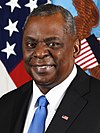 Lloyd Austin |
January 22, 2021 |
 Attorney General (28 U.S.C. § 503) |
 Merrick Garland |
March 11, 2021 |
 Secretary of the Interior (43 U.S.C. § 1451) |
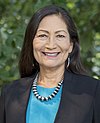 Deb Haaland |
March 16, 2021 |
 Secretary of Agriculture (7 U.S.C. § 2202) |
 Tom Vilsack |
February 24, 2021 |
 Secretary of Commerce (15 U.S.C. § 1501) |
 Gina Raimondo |
March 3, 2021 |
 Secretary of Labor (29 U.S.C. § 551) |
 Julie Su Acting |
March 11, 2023 |
 Secretary of Health and Human Services (Reorganization Plan No. 1 of 1953, 67 Stat. 631 and 42 U.S.C. § 3501) |
 Xavier Becerra |
March 19, 2021 |
 Secretary of Housing and Urban Development (42 U.S.C. § 3532) |
 Marcia Fudge |
March 10, 2021 |
 Secretary of Transportation (49 U.S.C. § 102) |
 Pete Buttigieg |
February 3, 2021 |
 Secretary of Energy (42 U.S.C. § 7131) |
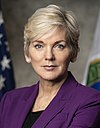 Jennifer Granholm |
February 25, 2021 |
 Secretary of Education (20 U.S.C. § 3411) |
 Miguel Cardona |
March 2, 2021 |
 Secretary of Veterans Affairs (38 U.S.C. § 303) |
 Denis McDonough |
February 9, 2021 |
 Secretary of Homeland Security (6 U.S.C. § 112) |
 Alejandro Mayorkas |
February 2, 2021 |
Cabinet-level officials[edit]
The president may designate additional positions to be members of the Cabinet, which can vary under each president. They are not in the line of succession and are not necessarily officers of the United States.[9]
| Office | Incumbent | Term began |
|---|---|---|
 Administrator of the Environmental Protection Agency (5 U.S.C. § 906, Executive Order 11735) |
 Michael S. Regan |
March 11, 2021 |
 Director of the Office of Management and Budget (31 U.S.C. § 502, Executive Order 11541, Executive Order 11609, Executive Order 11717) |
 Shalanda Young |
March 24, 2021 |
 Director of National Intelligence (50 U.S.C. § 3023) |
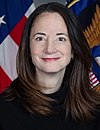 Avril Haines |
January 21, 2021 |
 Trade Representative (19 U.S.C. § 2171) |
 Katherine Tai |
March 18, 2021 |
 Ambassador to the United Nations (22 U.S.C. § 287) |
 Linda Thomas-Greenfield |
February 25, 2021 |
 Chair of the Council of Economic Advisers (15 U.S.C. § 1023) |
Vacant | March 31, 2023 |
 Administrator of the Small Business Administration (15 U.S.C. § 633) |
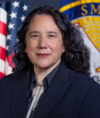 Isabel Guzman |
March 17, 2021 |
 Director of the Office of Science and Technology Policy (42 U.S.C. § 6612) |
 Arati Prabhakar |
October 3, 2022 |
 White House Chief of Staff (Pub. L. 76–19, 53 Stat. 561, enacted April 3, 1939, Executive Order 8248, Executive Order 10452, Executive Order 12608) |
 Jeff Zients |
February 7, 2023 |
Former executive and Cabinet-level departments[edit]
- Department of War (1789–1947), headed by the secretary of war: renamed Department of the Army by the National Security Act of 1947.
- Department of the Navy (1798–1949), headed by the secretary of the Navy: became a military department within the Department of Defense.
- Post Office Department (1829–1971), headed by the postmaster general: reorganized as the United States Postal Service, an independent agency.
- National Military Establishment (1947–1949), headed by the secretary of Defense: created by the National Security Act of 1947 and recreated as the Department of Defense in 1949.
- Department of the Army (1947–1949), headed by the secretary of the Army: became a military department within the Department of Defense.
- Department of the Air Force (1947–1949), headed by the secretary of the Air Force: became a military department within the Department of Defense.
Renamed heads of the executive departments[edit]
- Secretary of Foreign Affairs: created in July 1781 and renamed Secretary of State in September 1789.[10]
- Secretary of War: created in 1789 and was renamed as Secretary of the Army by the National Security Act of 1947. The 1949 Amendments to the National Security Act of 1947 made the secretary of the Army a subordinate to the secretary of defense.
- Secretary of Commerce and Labor: created in 1903 and renamed Secretary of Commerce in 1913 when its labor functions were transferred to the new secretary of labor.
- Secretary of Health, Education, and Welfare: created in 1953 and renamed Secretary of Health and Human Services in 1979 when its education functions were transferred to the new secretary of education.
Positions intermittently elevated to Cabinet-rank[edit]
- Ambassador to the United Nations (1953–1989, 1993–2001, 2009–2018, 2021–present)
- Director of the Office of Management and Budget (1953–1961, 1969–present)
- White House Chief of Staff (1953–1961, 1974–1977, 1993–present)
- Counselor to the President (1969–1977, 1981–1985, 1992–1993): A title used by high-ranking political advisers to the president of the United States and senior members of the Executive Office of the President since the Nixon administration.[11] Incumbents with Cabinet rank included Daniel Patrick Moynihan, Donald Rumsfeld and Anne Armstrong.
- White House Counsel (1974–1977)
- United States Trade Representative (1975–present)
- Chair of the Council of Economic Advisers (1977–1981, 1993–2001, 2009–2017, 2021–present)
- National Security Advisor (1977–1981)
- Director of Central Intelligence (1981–1989, 1995–2001)[12][13][14]
- Administrator of the Environmental Protection Agency (1993–present)
- Director of the Office of National Drug Control Policy (1993–2009)[15][16]
- Administrator of the Small Business Administration (1994–2001, 2012–present)
- Director of the Federal Emergency Management Agency (1996–2001): Created as an independent agency in 1979, raised to Cabinet rank in 1996,[17] and dropped from Cabinet rank in 2001.[18]
- Director of National Intelligence (2017–present)
- Director of the Central Intelligence Agency (2017–2021)
- Director of the Office of Science and Technology Policy (2021–present)
Proposed Cabinet departments[edit]
- Department of Industry and Commerce, proposed by Secretary of the Treasury William Windom in a speech given at a Chamber of Commerce dinner in May 1881.[19]
- Department of Natural Resources, proposed by the Eisenhower administration,[20] President Richard Nixon,[21] the 1976 GOP national platform,[22] and by Bill Daley (as a consolidation of the Departments of the Interior and Energy, and the Environmental Protection Agency).[23]
- Department of Peace, proposed by Senator Matthew Neely in the 1930s, Congressman Dennis Kucinich, 2020 presidential candidate Marianne Williamson, and other members of the U.S. Congress.[24][25]
- Department of Social Welfare, proposed by President Franklin Roosevelt in January 1937.[26]
- Department of Public Works, proposed by President Franklin Roosevelt in January 1937.[26]
- Department of Conservation (renamed Department of the Interior), proposed by President Franklin Roosevelt in January 1937.[26]
- Department of Urban Affairs and Housing, proposed by President John F. Kennedy.[27]
- Department of Business and Labor, proposed by President Lyndon Johnson.[28]
- Department of Community Development, proposed by President Richard Nixon; to be chiefly concerned with rural infrastructure development.[21][29]
- Department of Human Resources, proposed by President Richard Nixon; essentially a revised Department of Health, Education, and Welfare.[21]
- Department of Economic Affairs, proposed by President Richard Nixon; essentially a consolidation of the Departments of Commerce, Labor, and Agriculture.[30]
- Department of Environmental Protection, proposed by Senator Arlen Specter and others.[31]
- Department of Intelligence, proposed by former Director of National Intelligence Mike McConnell.[32]
- Department of Global Development, proposed by the Center for Global Development.[33]
- Department of Art, proposed by Quincy Jones.[34]
- Department of Business, proposed by President Barack Obama as a consolidation of the U.S. Department of Commerce’s core business and trade functions, the Small Business Administration, the Office of the U.S. Trade Representative, the Export-Import Bank, the Overseas Private Investment Corporation, and the U.S. Trade and Development Agency.[35][36]
- Department of Education and the Workforce, proposed by President Donald Trump as a consolidation of the Departments of Education and Labor.[37]
- Department of Health and Public Welfare, proposed by President Donald Trump as a renamed Department of Health and Human Services.[38]
- Department of Economic Development, proposed by Senator Elizabeth Warren to replace the Commerce Department, subsume other agencies like the Small Business Administration and the Patent and Trademark Office, and include research and development programs, worker training programs, and export and trade authorities like the Office of the U.S. Trade Representative with the single goal of creating and protecting American jobs.[39]
- Department of Technology, proposed by businessman and 2020 Democratic presidential candidate Andrew Yang.[40]
- Department of Culture, patterned on similar departments in many foreign nations, proposed by, among others, Murray Moss[41] and Jeva Lange.[42]
See also[edit]
- Black Cabinet
- Brain trust
- Cabinet of Joe Biden
- Cabinet of the Confederate States of America
- Kitchen Cabinet
- List of African-American United States Cabinet members
- List of Hispanic and Latino American United States Cabinet members
- List of female United States Cabinet members
- List of foreign-born United States Cabinet members
- List of people who have held multiple United States Cabinet-level positions
- List of United States Cabinet members who have served more than eight years
- List of United States political appointments that crossed party lines
- St. Wapniacl (historical mnemonic acronym)
- Unsuccessful nominations to the Cabinet of the United States
References[edit]
- ^ «Cabinet Room—White House Museum». www.whitehousemuseum.org. Retrieved March 17, 2021.
- ^ Prakash, Sai. «Essays on Article II:Executive Vesting Clause». The Heritage Guide to The Constitution. The Heritage Foundation. Archived from the original on July 1, 2018. Retrieved July 3, 2018.
- ^ a b Gaziano, Todd. «Essays on Article II: Opinion Clause». The Heritage Guide to The Constitution. The Heritage Foundation. Archived from the original on July 1, 2018. Retrieved July 3, 2018.
- ^ «John Adams · George Washington’s Mount Vernon». Archived from the original on May 17, 2018. Retrieved May 17, 2018.
- ^ Wulwick, Richard P.; Macchiarola, Frank J. (1995). «Congressional Interference With The President’s Power To Appoint» (PDF). Stetson Law Review. XXIV: 625–652. Archived (PDF) from the original on November 16, 2016. Retrieved November 15, 2016.
- ^ Pierce, Olga (January 22, 2009). «Who Runs Departments Before Heads Are Confirmed?». ProPublica. Archived from the original on February 2, 2017. Retrieved January 20, 2017.
- ^ Obama, Barack (December 19, 2014). «Adjustments of Certain Rates of Pay» (PDF). Executive Order 13686. The White House. Archived (PDF) from the original on February 1, 2017. Retrieved September 18, 2015.
- ^ Purcell, Patrick J. (January 21, 2005). «Retirement Benefits for Members of Congress» (PDF). CRS Report for Congress. Congressional Research Service. Archived (PDF) from the original on January 3, 2018. Retrieved February 19, 2017.
- ^ The White House. «The Cabinet». Retrieved February 6, 2021.
- ^ The office of Secretary of Foreign Affairs existed under the Articles of Confederation from October 20, 1781, to March 3, 1789, the day before the Constitution came into force.
- ^ «Clayton Yeutter’s Obituary». The Washington Post. Archived from the original on December 31, 2018.
- ^ Tenet, George (2007). At the Center of the Storm. London: HarperCollins. p. 136. ISBN 978-0-06-114778-4.
Under President Clinton, I was a Cabinet member—a legacy of John Deutch’s requirement when he took the job as DCI—but my contacts with the president, while always interesting, were sporadic. I could see him as often as I wanted but was not on a regular schedule. Under President Bush, the DCI lost its Cabinet-level status.
- ^ Schoenfeld, Gabriel (July–August 2007). «The CIA Follies (Cont’d.)». Commentary. Retrieved May 22, 2009.
Though he was to lose the Cabinet rank he had enjoyed under Clinton, he came to enjoy «extraordinary access» to the new President, who made it plain that he wanted to be briefed every day.
[permanent dead link] - ^ Sciolino, Elaine (September 29, 1996). «C.I.A. Chief Charts His Own Course». New York Times. Archived from the original on May 30, 2013. Retrieved May 22, 2009.
It is no secret that Mr. Deutch initially turned down the intelligence position, and was rewarded for taking it by getting Cabinet rank.
- ^ Clinton, Bill (July 1, 1993). «Remarks by the President and Lee Brown, Director of Office of National Drug Control Policy». White House. Archived from the original on July 21, 2011. Retrieved May 22, 2009.
We are here today to install a uniquely qualified person to lead our nation’s effort in the fight against illegal drugs and what they do to our children, to our streets, and to our communities. And to do it for the first time from a position sitting in the President’s Cabinet.
- ^ Cook, Dave (March 11, 2009). «New drug czar gets lower rank, promise of higher visibility». Christian Science Monitor. Archived from the original on March 15, 2009. Retrieved March 16, 2009.
For one thing, in the Obama administration the Drug Czar will not have Cabinet status, as the job did during George W. Bush’s administration.
- ^ «President Clinton Raises FEMA Director to Cabinet Status» (Press release). Federal Emergency Management Agency. February 26, 1996. Archived from the original on January 16, 1997. Retrieved May 22, 2009.
- ^ Fowler, Daniel (November 19, 2008). «Emergency Managers Make It Official: They Want FEMA Out of DHS». CQ Politics. Archived from the original on November 29, 2008. Retrieved March 3, 2010.
During the Clinton administration, FEMA Administrator James Lee Witt met with the Cabinet. His successor in the Bush administration, Joe M. Allbaugh, did not.
(Archived March 3, 2010, by WebCite at - ^ «A Department of Commerce». The New York Times. May 13, 1881.
- ^ Improving Management and Organization in Federal Natural Resources and Environmental Functions: Hearing Before the Committee on Governmental Affairs, U. S. Senate. Diane Publishing. April 1, 1998. ISBN 9780788148743. Archived from the original on January 14, 2019. Retrieved February 20, 2017 – via Google Books.
Chairman Stevens. Thank you very much. I think both of you are really pointing in the same direction as this Committee. I do hope we can keep it on a bipartisan basis. Mr. Dean, when I was at the Interior Department, I drafted Eisenhower’s Department of Natural Resources proposal, and we have had a series of them that have been presented.
- ^ a b c «116—Special Message to the Congress on Executive Branch Reorganization». The University of California, Santa Barbara—The American Presidency Project. Archived from the original on February 14, 2017. Retrieved February 13, 2017.
The administration is today transmitting to the Congress four bills which, if enacted, would replace seven of the present executive departments and several other agencies with four new departments: the Department of Natural Resources, the Department of Community Development, the Department of Human Resources and the Department of Economic Affairs.
- ^ «Republican Party Platform of 1976». The University of California, Santa Barbara—The American Presidency Project. August 18, 1976. Archived from the original on April 2, 2015. Retrieved March 13, 2015.
- ^ Thrush, Glenn (November 8, 2013). «Locked in the Cabinet». Politico. Archived from the original on November 17, 2013. Retrieved November 18, 2013.
- ^ Schuman, Frederick L. (1969). Why a Department of Peace. Beverly Hills: Another Mother for Peace. p. 56. OCLC 339785.
- ^ «History of Legislation to Create a Dept. of Peace». Archived from the original on July 20, 2006.
- ^ a b c «10—Summary of the Report of the Committee on Administrative Management». The University of California, Santa Barbara—The American Presidency Project. Archived from the original on February 13, 2017. Retrieved February 13, 2017.
Overhaul the more than 100 separate departments, boards, commissions, administrations, authorities, corporations, committees, agencies and activities which are now parts of the Executive Branch, and theoretically under the President, and consolidate them within twelve regular departments, which would include the existing ten departments and two new departments, a Department of Social Welfare, and a Department of Public Works. Change the name of the Department of Interior to Department of Conservation.
- ^ «23—Special Message to the Congress Transmitting Reorganization Plan 1 of 1962». The University of California, Santa Barbara—The American Presidency Project. Archived from the original on February 14, 2017. Retrieved February 13, 2017.
- ^ «121–Special Message to the Congress: The Quality of American Government». The University of California, Santa Barbara—The American Presidency Project. Archived from the original on February 14, 2017. Retrieved February 13, 2017.
In my State of the Union Address, and later in my Budget and Economic Messages to the Congress, I proposed the creation of a new Department of Business and Labor.
- ^ «33—Special Message to the Congress on Rural Development». The University of California, Santa Barbara—The American Presidency Project. Archived from the original on February 14, 2017. Retrieved February 13, 2017.
- ^ «116—Special Message to the Congress on Executive Branch Reorganization». The University of California, Santa Barbara—The American Presidency Project. Archived from the original on February 14, 2017. Retrieved February 13, 2017.
The new Department of Economic Affairs would include many of the offices that are now within the Departments of Commerce, Labor and Agriculture. A large part of the Department of Transportation would also be relocated here, including the United States Coast Guard, the Federal Railroad Administration, the St. Lawrence Seaway Development Corporation, the National Transportation Safety Board, the Transportation Systems Center, the Federal Aviation Administration, the Motor Carrier Safety Bureau and most of the National Highway Traffic Safety Administration. The Small Business Administration, the Science Information Exchange program from the Smithsonian Institution, the National Institute for Occupational Health and Safety from the Department of Health, Education, and Welfare and the Office of Technology Utilization from the National Aeronautics and Space Administration would also be included in the new Department.
- ^ «Public Notes on 02-RMSP3». Archived from the original on June 13, 2017. Retrieved February 20, 2017.
- ^ «A Conversation with Michael McConnell». Council on Foreign Relations (Federal News Service, rush transcript). June 29, 2007. Archived from the original on January 17, 2013. Retrieved January 9, 2013.
- ^ «Time for a Cabinet-Level U.S. Department of Global Development». The Center for Global Development. Archived from the original on January 14, 2019. Retrieved February 15, 2017.
- ^ Clarke, Jr., John (January 16, 2009). «Quincy Jones Lobbies Obama for Secretary of Culture Post». Rolling Stone. Archived from the original on September 8, 2012. Retrieved August 19, 2010.
{{cite magazine}}: CS1 maint: multiple names: authors list (link) - ^ «President Obama Announces proposal to reform, reorganize and consolidate Government». whitehouse.gov. Archived from the original on February 11, 2017. Retrieved February 8, 2017 – via National Archives.
- ^ «Obama Suggests ‘Secretary of Business’ in a 2nd Term—Washington Wire—WSJ». The Wall Street Journal. Archived from the original on March 1, 2017. Retrieved August 4, 2017.
- ^ «White House Proposes Merging Education And Labor Departments». NPR.org. Archived from the original on June 21, 2018. Retrieved June 22, 2018.
- ^ «Delivering Government Solutions in the 21st Century | Reform Plan and Reorganization Recommendations» (PDF). whitehouse.gov. 2018. Archived (PDF) from the original on April 12, 2019.
- ^ Warren, Team (June 4, 2019). «A Plan For Economic Patriotism». Medium. Archived from the original on July 31, 2019. Retrieved July 30, 2019.
- ^ «Regulate AI and other Emerging Technologies». Andrew Yang for President. Archived from the original on August 20, 2019. Retrieved August 21, 2019.
- ^ Garber, Megan (July 1, 2013). «Should the U.S. Have a Secretary of Culture?». The Atlantic. Retrieved January 22, 2021.
- ^ «Hey Joe—appoint a culture secretary». theweek.com. November 16, 2020. Retrieved January 22, 2021.
Further reading[edit]
- Bennett, Anthony. The American President’s Cabinet. Houndmills, Basingstoke, Hampshire: Macmillan, 1996. ISBN 0-333-60691-4. A study of the U.S. Cabinet from Kennedy to Clinton.
- Grossman, Mark. Encyclopedia of the United States Cabinet (Santa Barbara, California: ABC-CLIO; three volumes, 2000; reprint, New York: Greyhouse Publishing; two volumes, 2010). A history of the United States and Confederate States Cabinets, their secretaries, and their departments.
- Rudalevige, Andrew. «The President and the Cabinet», in Michael Nelson, ed., The Presidency and the Political System, 8th ed. (Washington, D.C.: CQ Press, 2006).
External links[edit]
- Official site of the President’s Cabinet
- U.S. Senate’s list of Cabinet members who did not attend the State of the Union Address (since 1984)
Наталья Николаевна Чувелева
Эксперт по предмету «Политология»
преподавательский стаж — 20 лет
Задать вопрос автору статьи
Кабинет министров США
Определение 1
Кабинет министров США – это высший орган управления исполнительной властью федерального правительства при президенте Соединенных Штатов.
Кабинет министров США назначается непосредственно президентом с согласия Сената.
Институт кабинета президента возник при Джордже Вашингтоне, первом президенте США, который в конце XVIII века создал кабинет из особо приближенных к нему советников: Томаса Джефферсона (государственного секретаря США), Александра Гамильтона (министра финансов США), Генри Нокса (военного министра и Эдмунда Рэндольфа (генерального прокурора США). Цель создания кабинета министров: предоставление помощи президенту США в выполнении его обязанностей.
Сделаем домашку
с вашим ребенком за 380 ₽
Уделите время себе, а мы сделаем всю домашку с вашим ребенком в режиме online
Бесплатное пробное занятие
*количество мест ограничено
Все члены кабинета министров Америки, за исключением генерального почтмейстера США и генерального прокурора США, являются руководителями всех центральных органов управления государством и называются «секретарями» (в системе государственных органов управления это соответствует должности министра), исключение – государственный секретарь США, или министр иностранных дел.
Порядок назначения администрации президента:
- Президент США предлагает кандидатов на посты в кабинете министров и предоставляет соответствующий список Сенату США для рассмотрения и утверждения кандидатов в должности.
- Утверждение проводится большинством голосов Сената.
- После одобрения кандидатов на должности министров в кабинете при президенте, они приносят клятву государству и народу США и приступают к выполнению своих должностных обязанностей.
Замечание 1
Некоторые должностные лица федерального правительства Америки, а именно: Директор ЦРУ (Центральное разведывательное управление), Директор Национальной разведки, на свои должности утверждаются Сенатом, но в состав Кабинета министров не входят.
«Кабинет министров США, его состав » 👇
Структура Кабинета министров США
На современном этапе развития кабинет министров США в его состав входят 15 министров, которые возглавляют ряд министерств:
- министерство финансов (министр Стивен Мнучин);
- министерство сельского хозяйства (министр Сонни Пердью);
- министерство торговли (министр Уилбур Росс);
- министерство образования (министр Бетси Девос);
- министерство обороны (министр Джеймс Мэттис);
- министерство энергетики (министр Рик Перри);
- министерство здравоохранения и социальных служб (министр Алекс Азар);
- министерство внутренней безопасности (министр Кирстен Нильсен);
- министерство жилищного строительства и городского развития (министр Бен Карсон);
- министерство юстиции (Генеральный прокурор Джефф Сешнс);
- министерство труда (министр Александр Акоста);
- министерство внутренних дел (министр Райан Зинке);
- министерство транспорта (министр Элейн Чао);
- министерство по делам ветеранов (министр Роберт Уилки).
Помимо Президента США в состав Кабинета входит вице-президент США (премьер-министр) (Майк Пенс), государственный секретарь (Майк Помпео), Глава аппарата Белого дома (Джон Келли), торговый представитель США (Роберт Лайтхайзер), Директор Национальной разведки (Дэн Коутс), постоянный представитель США при ООН (Никки Хейли), Директор Административно-бюджетного управления (Мик Малвейни), Администратор Агентства по охране окружающей среды (Скотт Прюитт), Администратор Управления по делам малого бизнеса (Линда Макмэн). В руководстве страной большая роль отводится Федеральному казначейству и Государственному департаменту.
Википедия дает полную информацию о каждом министре США.
Находи статьи и создавай свой список литературы по ГОСТу
Поиск по теме
https://ria.ru/20230411/dokumenty-1864365434.html
Экс-аналитик ЦРУ предположил, кто может стоять за утечками документов США
Экс-аналитик ЦРУ предположил, кто может стоять за утечками документов США — РИА Новости, 13.04.2023
Экс-аналитик ЦРУ предположил, кто может стоять за утечками документов США
Недавние утечки в СМИ секретных документов Пентагона, вероятнее всего, стали результатом действий одного лица в руководстве США, не согласного с политикой… РИА Новости, 13.04.2023
2023-04-11T01:18
2023-04-11T01:18
2023-04-13T23:53
россия
сша
филип джиральди
джо байден
эдвард сноуден
нато
в мире
утечка материалов пентагона
/html/head/meta[@name=’og:title’]/@content
/html/head/meta[@name=’og:description’]/@content
https://cdnn21.img.ria.ru/images/07e7/03/1b/1861056619_172:518:2888:2046_1920x0_80_0_0_678a8fdafb90e0619928d775ee106e27.jpg
ВАШИНГТОН, 11 апр – РИА Новости. Недавние утечки в СМИ секретных документов Пентагона, вероятнее всего, стали результатом действий одного лица в руководстве США, не согласного с политикой администрации президента Джо Байдена в сфере безопасности, заявил РИА Новости бывший аналитик ЦРУ Филип Джиральди.По его мнению, остается лишь гадать, сколько времени потребуется американским властям, чтобы вычислить виновного – учитывая, что доступ к слитым сеть данным потенциально могли иметь сотни чиновников. Вместе с тем, отмечает собеседник, для поимки преступника Пентагон распорядился задействовать «серьезные ресурсы».»Сегодня стало известно, что они изучают личные дела сотрудников и ограничивают доступ к будущим брифингам подобного рода. Предположу, что в скором времени начнутся проверки возможных подозреваемых на полиграфе», — прогнозирует бывший сотрудник ЦРУ.Вместе с тем, Джиральди дал понять, что не склонен переоценивать значение утекших данных и считать, что данное событие может поставить под угрозу какие-либо конкретные инициативы США из числа тех, что уже реализуются или пока планируются. «Было бы ошибкой считать это серьезной брешью в системе безопасности, если брать в расчет фактический ущерб, выходящий за рамки столь серьезного позора со стороны Пентагона», — резюмировал аналитик.В настоящее время Пентагон расследует утечку в соцсети материалов, где описываются состояние украинских войск и планы США и НАТО по их укреплению. Издание New York Times отмечало, что документы, датированные началом марта, якобы распространяются в «российских проправительственных телеграм-каналах». Утверждалось, в интернет могли попасть более 100 документов, ущерб от произошедшего оценивается как значительный. В Пентагоне уже сказали РИА Новости, что изучают информацию об утечке. Пресс-секретарь президента России Дмитрий Песков, отвечая на вопрос об утечке, говорил, что у Москвы нет сомнений в том, что США и НАТО прямо или косвенно вовлечены в конфликт.
https://ria.ru/20230411/somneniya-1864372611.html
https://ria.ru/20230410/utechka-1864175947.html
россия
сша
РИА Новости
internet-group@rian.ru
7 495 645-6601
ФГУП МИА «Россия сегодня»
https://xn--c1acbl2abdlkab1og.xn--p1ai/awards/
2023
РИА Новости
internet-group@rian.ru
7 495 645-6601
ФГУП МИА «Россия сегодня»
https://xn--c1acbl2abdlkab1og.xn--p1ai/awards/
Новости
ru-RU
https://ria.ru/docs/about/copyright.html
https://xn--c1acbl2abdlkab1og.xn--p1ai/
РИА Новости
internet-group@rian.ru
7 495 645-6601
ФГУП МИА «Россия сегодня»
https://xn--c1acbl2abdlkab1og.xn--p1ai/awards/
https://cdnn21.img.ria.ru/images/07e7/03/1b/1861056619_279:0:3010:2048_1920x0_80_0_0_7427d090b96dbf3bd4a2038755dc8535.jpg
РИА Новости
internet-group@rian.ru
7 495 645-6601
ФГУП МИА «Россия сегодня»
https://xn--c1acbl2abdlkab1og.xn--p1ai/awards/
РИА Новости
internet-group@rian.ru
7 495 645-6601
ФГУП МИА «Россия сегодня»
https://xn--c1acbl2abdlkab1og.xn--p1ai/awards/
россия, сша, филип джиральди, джо байден, эдвард сноуден, нато, в мире, утечка материалов пентагона
Россия, США, Филип Джиральди, Джо Байден, Эдвард Сноуден, НАТО, В мире, Утечка материалов Пентагона
Экс-аналитик ЦРУ предположил, кто может стоять за утечками документов США
Экс-аналитик ЦРУ Джиральди: за утечками документов стоит один человек в руководстве США
ВАШИНГТОН, 11 апр – РИА Новости. Недавние утечки в СМИ секретных документов Пентагона, вероятнее всего, стали результатом действий одного лица в руководстве США, не согласного с политикой администрации президента Джо Байдена в сфере безопасности, заявил РИА Новости бывший аналитик ЦРУ Филип Джиральди.
«
«Утечка, скорее всего, стала делом рук одного человека, чьи взгляды полностью расходятся с нынешней политикой властей США в сфере национальной безопасности – например, некоего Эдварда Сноудена, стремящегося раскрыть детали политики в отношении Украины и России», — предположил он.
По его мнению, остается лишь гадать, сколько времени потребуется американским властям, чтобы вычислить виновного – учитывая, что доступ к слитым сеть данным потенциально могли иметь сотни чиновников. Вместе с тем, отмечает собеседник, для поимки преступника Пентагон распорядился задействовать «серьезные ресурсы».
«Сегодня стало известно, что они изучают личные дела сотрудников и ограничивают доступ к будущим брифингам подобного рода. Предположу, что в скором времени начнутся проверки возможных подозреваемых на полиграфе», — прогнозирует бывший сотрудник ЦРУ.
СМИ: США усомнились в результатах ожидаемого наступления ВСУ
Вместе с тем, Джиральди дал понять, что не склонен переоценивать значение утекших данных и считать, что данное событие может поставить под угрозу какие-либо конкретные инициативы США из числа тех, что уже реализуются или пока планируются.
«Было бы ошибкой считать это серьезной брешью в системе безопасности, если брать в расчет фактический ущерб, выходящий за рамки столь серьезного позора со стороны Пентагона», — резюмировал аналитик.
В настоящее время Пентагон расследует утечку в соцсети материалов, где описываются состояние украинских войск и планы США и НАТО по их укреплению. Издание New York Times отмечало, что документы, датированные началом марта, якобы распространяются в «российских проправительственных телеграм-каналах». Утверждалось, в интернет могли попасть более 100 документов, ущерб от произошедшего оценивается как значительный. В Пентагоне уже сказали РИА Новости, что изучают информацию об утечке.
Пресс-секретарь президента России Дмитрий Песков, отвечая на вопрос об утечке, говорил, что у Москвы нет сомнений в том, что США и НАТО прямо или косвенно вовлечены в конфликт.
В утекших документах США есть сценарии поставок Израилем оружия Украине
Недавние утечки в Сеть секретных документов Пентагона, вероятнее всего, стали результатом действий одного лица в руководстве США, не согласного с политикой американских властей. Такое мнение высказал бывший аналитик ЦРУ Филип Джиральди.
По его словам, это мог быть человек, чьи взгляды полностью расходятся с политикой администрации президента Джо Байдена в сфере национальной безопасности. «Например, некоего Эдварда Сноудена, стремящегося раскрыть детали политики в отношении Украины и России», — цитирует РИА Новости Джиральди.
Он отметил, что остается лишь гадать, сколько времени потребуется для того, чтобы установить виновного, учитывая, что доступ к слитым в интернет данным могли иметь сотни чиновников. Для поимки преступника Пентагон распорядился задействовать «серьезные ресурсы», добавил собеседник агентства. «Они изучают личные дела сотрудников и ограничивают доступ к будущим брифингам», — сообщил Джиральди, предположив, что в скором времени начнутся проверки подозреваемых на полиграфе.
Экс-сотрудник ЦРУ дал понять, что не склонен переоценивать значение утекших документов. Было бы ошибкой считать это серьезной брешью в системе безопасности, «если брать в расчет фактический ущерб, выходящий за рамки столь серьезного позора со стороны Пентагона», резюмировал аналитик.
Напомним, на прошлой неделе газета New York Times сообщила, что Пентагон расследует утечку в соцсети секретных документов с описанием состояния украинской армии и планов США и НАТО по ее укреплению перед запланированным наступлением. Спустя несколько дней, стало известно, что еще одна партия секретных документов США появилась в Сети. На этот раз в них речь идет не только об Украине, но и о КНР и Ближнем Востоке. Всего в общем доступе оказались более 100 документов, утверждает издание.
Некоторые эксперты полагают, что данные сообщения являются частью целенаправленной кампании по дезинформации.

